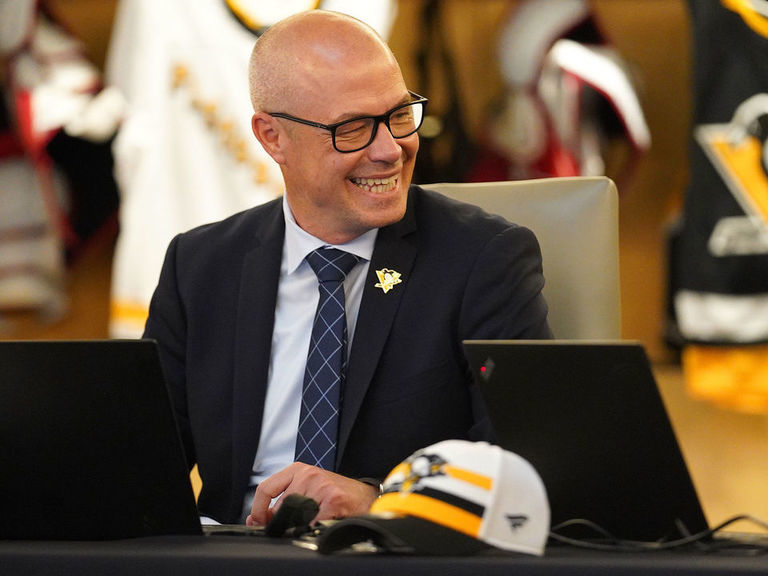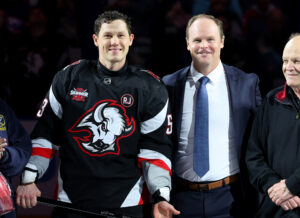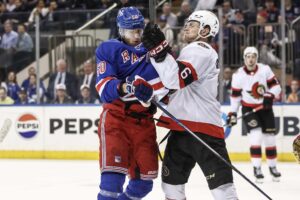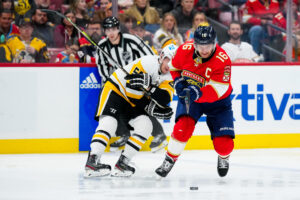The Vancouver Canucks trading from strength is the only real option to change the team.
“The most shocking thing that could happen at the draft is nothing happening at the draft.”
-Various Canucks pundits, before July 7th.
Canucks Need Trades
The current iteration of the Vancouver Canucks can start the 2022-23 season. They have a full contingent of players signed, and while they’re currently over the salary cap it will be easy enough to maneuver back under. The players are decent enough to compete for a playoff spot in a weak Pacific Division. But that’s not what they want, is it?
After several years of trying to return to that 2011 high, a second wholesale change of management should mean a new direction. Indeed, when asked General Manager Patrik Allvin talked up changes in player makeup and salaries. Neither of those has really happened so far. They haven’t done nothing, of course, but the changes aren’t dramatic ones so far.
Free agency has been very productive for the Canucks. They’ve signed the top scorer in the WHL, changed up minor parts of the defence, and turned over the fourth line. The bottom-six was a serious problem for Vancouver, so the improved depth among forwards helps. And given the contracts they’ve been saddled with, next season has always been the more realistic time for change. As we mentioned, it’s been a long time since there has been any kind of plan beyond a single season. Vancouver’s used one first-, one second-, two third-, and two fourth-round draft picks in the past three seasons. That’s six out of twelve picks meant to build the future.
Still: new management, new goals, right?
Hopes and Dreams and Rolling Up Sleeves
The problem is that it has yet to be proven what the goal is. It’s going to be a matter of time – and one or two BIG deals – before the target is irrevocably selected. For now, we can only take them at their word. What Allvin has said his goals are is to get faster, clear cap space, and improve the defence. Looking over what’s left in free agency finds some very slim pickings, especially for the money available.
Though realistically, the free agent signings the Canucks have managed have made the team faster. They’ve also improved the defence, though through responsible forwards rather than shut-down defence. All that is good. The forwards look deeper and more talented than the previous season, certainly. Almost as if they expected to lose a high-end forward to bolster their defence. Weird, that.
Report: Canucks to name Patrik Allvin as GM https://t.co/bm6taQdXYP pic.twitter.com/b4wsWy325v
— theScore NHL (@theScoreNHL) January 26, 2022
Not that change is a new thing to the remaining Canucks forwards. Only one line played more than 200 minutes together in 2021-22, and none of Tyler Motte, Matthew Highmore, or Juho Lammikko remain. After them, the most common line was a duo. Tanner Pearson and J.T. Miller played over 350 minutes together with Conor Garland or Brock Boeser on the right side. Very effectively, too, with an expected goals rating for either combination just under 60%.
Now, for folks who are watching the team, this is an interesting conundrum. Three of the four players mentioned also come up in trade speculation. Boeser’s new deal means he probably isn’t going anywhere just now. Which leaves everyone else.
Gaining Value Overall vs Every Deal
That is to say, the other three forwards. The best trades may be surprising ones, but the best chance of getting a good deal has the Canucks trading from strength. Their blueline corps obviously isn’t it. And with apologies to Thatcher Demko, goaltending can hardly be considered a strength right now. Beyond the starter lie question marks and maybes and that’s it. So any deal made has to be done with the forwards as bait.
Each of the players mentioned can be moved on their own or as part of a bigger deal. If they are used as a sweetener to convince another team to take some cap hit then obviously the return goes down. That’s should be avoided simply because the Canucks will want as much as possible. That being said, gaining cap space has value of its own. But if the team has no actual plan for it, it’s not going to help much. “Losing” a deal – even a small one – can help beyond the skill of the players involved.
The biggest reason there is little temptation in the free agent market is what Vancouver already has. Anyone coming on what they can afford bumps someone – who may or may not be better. If Tucker Poolman returns, the Canucks have four or five players who are a good fit on the bottom pair. How is getting another one helpful? Especially when they’re already 30 years old or older. Whoever comes in on the already crowded left side is just going to get in Jack Rathbone‘s way.
A trade that gains that space is going to be a good one, or can be, anyway. Get a mid-round pick back and consider the minor amount of space in return the primary benefit. Then turn back to the forwards.
Gain Through Loss
The Canucks trading from strength means one – or more – of their forwards is going the other way. Jason Dickinson‘s awful season means his value is rock bottom. Justin Dowling is very unlikely to start in Vancouver. Nils Höglander has potential, but most buyers will want to see more before paying anything substantial for him.* Which forward gets moved will have different effects on the team. Whether any deal is good or not depends a LOT on not just what comes back but how they fill that space.
Tanner Pearson
When you look over Pearson’s boxcars – 14 goals and 34 points in 68 games – he’s a middle-six guy. Not hard to replace, and probably scraping the bottom value of his $3.25 million cap hit. However, he also improved every line he was on last season, and mostly he was with J.T. Miller. The ability to play with a star isn’t the most considered skill, but it’s harder than you think. Pearson is a physical presence and is someone every player wants on his wing.
The Replacement: Andrei Kuzmenko has a sound defensive game to go with his – KHL – scoring touch. Starting him in the bottom-six is setting him up to fail, and the team will be very unhappy if that happens. He is the Great Unknown, but cost less than a million dollars.
Conor Garland
Garland drives plays. Like everyone else, he didn’t get much of a chance to find chemistry between the coaching change and those coaches loving their blenders. But even through that, he still picked up 19 goals and 52 points in his 16:24 average ice time. He and Höglander briefly flanked Elias Pettersson with some great results, but it’s hard to picture that as a permanent line. Vancouver has talked about wanting speed and drive, and he has both. He’s also being paid nearly $5 million a season for another four years. He’s worth it.
The Replacement: Ironically enough, Höglander might take his spot admirably. He doesn’t have Garland’s experience yet, but his engine doesn’t have a low gear either.
J.T. Miller
Hm. There is very little left to say that we haven’t by now – and in the Dog Days of August? There’s little chance of adding more. Until a deal gets done, the Canucks’ new management group is going to have an “Incomplete” on their report card. The conflict here is that he wants to be paid like the Canucks best player, and the Canucks don’t want him to be their best player. Certainly not for eight more seasons, anyway.
The Replacement: Well, no. Miller scored 99 points last season. The Canucks haven’t seen that level of production for a decade, and Miller kills penalties, too.
Bo Horvat
Let’s entertain the thought. Bo Horvat needs a new deal, and while he isn’t asking for Miller’s money, he’s been worth every penny of his $5.5 million cap hit. He hasn’t been worth a lot more than that, however, so how much he’s asking for matters. And for how long, of course. If he’s demanding a full-length extension, that cap hit will have to stay low. That all being said, he has been an excellent captain for the team in a demanding market. He can bring back almost as much as Miller because of his lower paycheque.
The Replacement: Ilya Mikheyev isn’t going to replicate Horvat’s 30 goals. He may well hit 20 regularly, though, and he brings more speed and more defensive acumen. His shooting percentage is unlikely to remain at his 2021-22 level of 14% but after just three NHL seasons, it’s a bit difficult to judge what his “normal” will be. With Vancouver, the winger will be given defensive responsibilities. That can seriously limit his opportunities. But at $4.75 million per season, it’s guaranteed he won’t ONLY play shorthanded.
*And Vancouver would be nuts to trade Höglander this early. The Canucks trading from strength also means knowing what you have.






